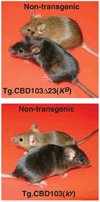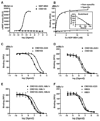A -defensin mutation causes black coat color in domestic dogs
- PMID: 17947548
- PMCID: PMC2906624
- DOI: 10.1126/science.1147880
A -defensin mutation causes black coat color in domestic dogs
Abstract
Genetic analysis of mammalian color variation has provided fundamental insight into human biology and disease. In most vertebrates, two key genes, Agouti and Melanocortin 1 receptor (Mc1r), encode a ligand-receptor system that controls pigment type-switching, but in domestic dogs, a third gene is implicated, the K locus, whose genetic characteristics predict a previously unrecognized component of the melanocortin pathway. We identify the K locus as beta-defensin 103 (CBD103) and show that its protein product binds with high affinity to the Mc1r and has a simple and strong effect on pigment type-switching in domestic dogs and transgenic mice. These results expand the functional role of beta-defensins, a protein family previously implicated in innate immunity, and identify an additional class of ligands for signaling through melanocortin receptors.
Figures





Comment in
-
Genetics. Beta-defensin repertoire expands.Science. 2007 Nov 30;318(5855):1395. doi: 10.1126/science.1151370. Science. 2007. PMID: 18048676 No abstract available.
References
-
- Bennett DC, Lamoreux ML. Pigment Cell Res. 2003;16:333. - PubMed
-
- Barsh GS. In: The Pigmentary System. Nordlund JJ, et al., editors. Oxford: Blackwell; 2006. pp. 395–410.
-
- Chhajlani V, Wikberg JE. FEBS Lett. 1992;309:417. - PubMed
-
- Mountjoy KG, Robbins LS, Mortrud MT, Cone RD. Science. 1992;257:1248. - PubMed
-
- Robbins LS, et al. Cell. 1993;72:827. - PubMed
Publication types
MeSH terms
Substances
Grants and funding
LinkOut - more resources
Full Text Sources
Other Literature Sources
Molecular Biology Databases

